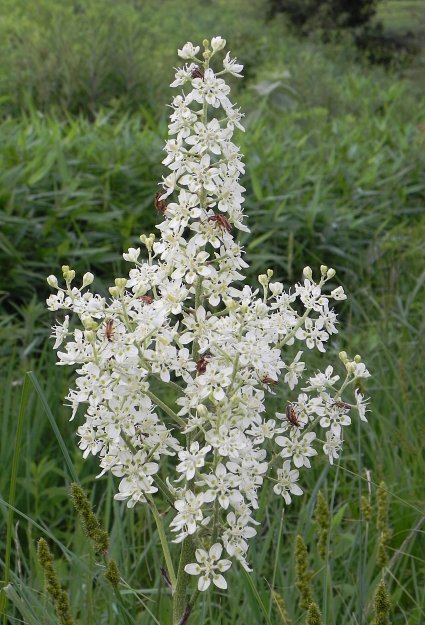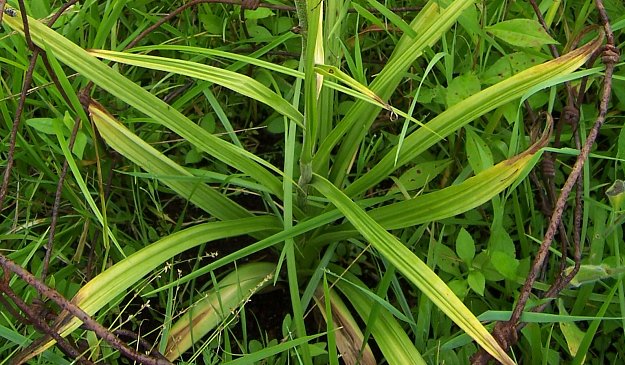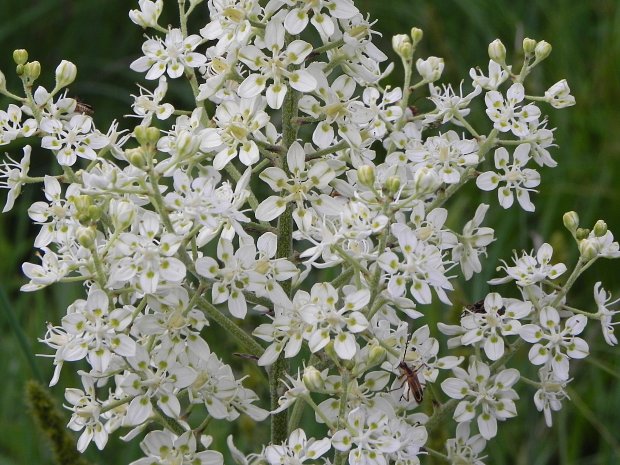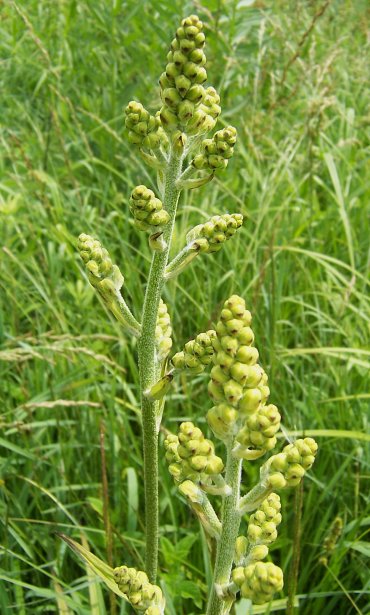Description: This is a herbaceous perennial plant about 2½–5' tall. At its base, there is a rosette of arching basal leaves. These basal leaves are 10-20" long and ½–1¼" across; they are medium green to yellowish green, glabrous, linear in shape, entire (toothless) along their margins, and often folded upward along their midveins. Leaf venation is parallel. A few alternate leaves occur along the central stem of this plant; they are similar to the basal leaves, except smaller in size. The central stem is light green, terete, relatively stout, and unbranched; it is usually glabrous below and pubescent with curly hairs above. The central stem terminates in a panicle of flowers about ¾–2' long and about one-half as much across. The lateral primary branches of this inflorescence are ascending, but not erect; they are somewhat longer toward the bottom and center of the inflorescence. Similar to the upper central stem, these floral branches are light green, terete, relatively stout, and pubescent with curly hairs.
At the base of each floral branch (including the pedicels), there is a linear-lanceolate bract up to ½" long that darkens and withers away with age. The pedicels (basal stalklets) of the flowers are about ¼–¾" long. Individual flowers are about ¾–1" across. Each flower has a white corolla with 6 spreading tepals, 6 stamens with white filaments, 3 white styles, and a light greenish yellow ovary. Individual tepals are lanceolate-oblong in shape, although they taper abruptly above their narrow bases. Just above their narrow bases, the tepals have 2 conspicuous glands that are yellow, green, or yellowish green. These glands secrete nectar. With age, the corollas become green or brownish purple. The flowers are replaced by ovoid-lanceoloid seed capsules up to 18 mm. (2/3") long. These capsules divide into 3 parts to release their seeds; each capsule contains 12 or more seeds. Individual seeds are 5-8 mm. long and about one-half as much across; they are straw-colored and somewhat irregular in shape. The root system is fibrous, short-rhizomatous, and relatively shallow. Clonal offsets can develop from the short rhizomes.
Cultivation: The preference is full or partial sun, wet to moist conditions, and fertile soil. Some standing water is tolerated if it is temporary. Several years of development are required before individual plants begin to flower.
Range & Habitat: The native Virginia Bunch-Flower occurs primarily in west-central Illinois, where it is rare and state-listed as 'threatened' (see Distribution Map). At one time, this plant was more common, but habitat destruction has resulted in population losses in several counties. In Illinois, habitats consist of damp prairies, especially along railroads, and wet ground along the bases of bluffs (these are often seeps). Outside of Illinois, Virginia Bunch-Flower has been found in open bottomland woodlands, damp meadows, swamps, marshes, fens, floating bogs, and roadside ditches. This conservative species is largely restricted to high quality habitats. To maintain populations of this plant within the state, cultivated plants should be used in prairie restorations.
Faunal Associations: Mostly flies and beetles visit the flowers of this plant, where they feed on the easy-to-access nectar, although some insect species may also feed on pollen. These floral visitors include Syrphid flies, Tachinid flies, blow flies (Lucilia spp.), Muscid flies, Anthomyiid flies, weevils, tumbling flower beetles, and flower scarab beetles. Some bees and wasps may also visit the flowers (Robertson, 1929). Because the foliage and roots of Virginia Bunch-Flower contain highly toxic alkaloids, they are not normally eaten by mammalian herbivores. This plant is especially poisonous to horses (Georgia, 1913).
Photographic Location: A prairie or sedge meadow at a nature preserve in Fayette County, Illinois. The photographs were taken by Keith & Patty Horn (Copyright © 2016).
Comments: Another species in the same genus, Melanthium woodii (Wood's Bunch-Flower), is a woodland species with wider leaves and reddish brown (maroon) flowers. The tepals of its flowers do not abruptly contract near their bases. Because of these differences, it is relatively easy to distinguish Wood's Bunch-Flower from Virginia Bunch-Flower. While there are other white-flowered Melanthium spp., they do not occur in Illinois. Some taxonomists prefer to merge the Melanthium genus with the Veratrum genus. When this happens, Virginia Bunchflower is referred to as Veratrum virginicum. Some taxonomists have divided the Lily family (Liliaceae) into several families, assigning the Melanthium genus to the Bunchflower family (Melanthiaceae). When it is in full bloom, Virginia Bunchflower is very showy and attractive.



